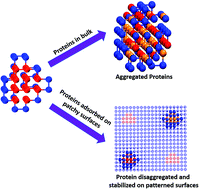Understanding the role of hydrophobic patches in protein disaggregation†
Abstract
Protein folding is a very complex process and, so far, the mechanism of folding still intrigues the research community. Despite a large conformational space available (O(1047) for a 100 amino acid residue), most proteins fold into their native state within a very short time. While small proteins fold relatively fast (a few microseconds) large globular proteins may take as long as several milliseconds to fold. During the folding process, the protein synthesized in the ribosome is exposed to the crowded environment of the cell and is easily prone to misfolding and aggregation due to interactions with other proteins or biomacromolecules present within the cell. These large proteins, therefore, rely on chaperones for their folding and repair. Chaperones are known to have hydrophobic patchy domains that play a crucial role in shielding the protein against misfolding and disaggregation of aggregated proteins. In the current article, Monte Carlo simulations carried out in the framework of the hydrophobic–polar (H–P) lattice model indicate that hydrophobic patchy domains drastically reduce the inter-protein interactions and are efficient in disaggregating proteins. The effectiveness of the disaggregation depends on the size and distribution of these patches on the surface and also on the strength of the interaction between the protein and the surface. Further, our results indicate that when the patch is complementary to the exposed hydrophobic patch of the protein, protein disaggregation is accompanied by stabilization of the protein even relative to its bulk behavior due to favorable protein–surface interactions. We believe that these findings shed light on the role of the class of chaperones known as heat shock proteins (Hsps) on protein disaggregation and refolding.

- This article is part of the themed collection: 2021 PCCP HOT Articles


 Please wait while we load your content...
Please wait while we load your content...